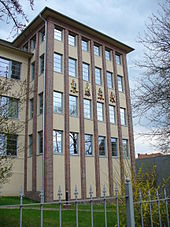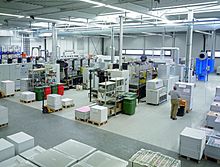ASS Altenburger
| Playing cards factory Altenburg GmbH
|
|
|---|---|
| legal form | GmbH |
| founding | 1832 |
| Seat |
Altenburg , Germany |
| management | Stefan Luther |
| Number of employees | 160 |
| Branch | Games industry |
| Website | www.spielkarten.com |
ASS Altenburger (ASS stands for Altenburger und Stralsunder Spielkartenfabrik ) has been the brand of Spielkartenfabrik Altenburg GmbH in the Skatstadt Altenburg since 2003 . The company belongs to the Belgian company Cartamundi from Turnhout . The brand is the market leader for playing cards in Germany . Almost 40 million different decks of cards are produced in Altenburg every year.
history
The history of the ASS Altenburger company begins at two locations in Germany: In Stralsund and Altenburg.
Stralsund playing card factories
In 1765 Johann Kaspar Kern founded a playing card factory in Stralsund, which Georg Friedrich Schlueter ran from 1793 and which was owned by the von der Osten family for several decades from 1823. In 1823 Ernst Joachim von der Osten took over the factory, followed by Ludwig von der Osten in 1845, Carl Ludwig von Zansen in 1859 and G. Mie in 1859, who also belonged to the von der Osten family. In 1846 Ludwig Heidborn founded a playing card factory, which produced until 1848 and then again after a long break from 1857. In 1848, another playing card factory was founded in Stralsund by Gustav Friedrich Diekelmann. This was headed from 1850 by Eugen Diekelmann, from 1855 by Theodor Wegener and from 1863 by Fritz Wegener.
The Stralsund company Ludwig von der Osten (owned by G. Mie) was formed on October 1, 1872 with the two Stralsund factories Ludwig Heidborn and Theodor Wegener (owned by Fritz Wegener) to form the United Stralsunder Spielkarten-Fabriken Aktien-Gesellschaft Stralsund (VSS AG) merged. The office was in the Knieperwall building , which had belonged to Heidborn. Production took place in the buildings of the Ostens and Wegeners. With the acquisition of the Lennhoff & Heuser playing card factory in Frankfurt am Main in 1882, VSS AG acquired several very popular card images, which had a positive influence on its continued success. In 1883 the former co-owner of this factory moved to Stralsund and became director of VSS AG.
The company grew steadily: in 1888 the Stralsund company Falkenberg & Co. (founded 1872) was bought, in 1891 the Tiedemann factory in Rostock , 1894 the Berlin playing card factory von Rochus Sala, 1895 the Hallesche Ludwig & Schmidt factory , 1897 the Altenburger playing card factory, 1901 Sutor from Naumburg (Saale) , 1905 Booch in Werdau and 1907 the Berlin Büttner & Cie. Further factories were bought up and integrated into the Stralsund company. In 1891/1892 production was switched to the cheaper letterpress printing process . The old, traditional map images of VSS AG disappeared. Still preserved today, but erroneously known as the Berlin image , a Stralsund scheme with French color symbols is the finest German Stralsunder .
The Stralsund factories manufactured most of the playing cards used on the German market and also produced them for export. In 1907 the Stralsund factory produced 3,340,000 playing cards. In 1913 235 workers were employed.
The following map images were produced: Bavarian image Stralsunder type, Bavarian image Munich type, Bongout image, Darmstadt double image (1872 to 1931), Finest German Stralsunders (1855 to 1892, wrongly known as Berlin image), Frankfurt image (from 1882) , Franconian picture (from 1885), French picture and double picture, Prussian picture (from 1840), Renaissance picture (from 1882), Rhenish picture (from approx. 1920), Rococo picture (from 1913), Royal picture, Saxon Picture (1882 to 1931), special pictures with German color symbols, tarot pictures with French color symbols, Württemberger Doppelbild (1882 to 1908). The Stralsund Museum keeps many, sometimes very rare, copies of the playing cards produced and shows them in a permanent exhibition.
However, the Stralsund company soon had a problem at its company location and founding headquarters in Stralsund: The business and production rooms were too small and the narrowness and the character of Stralsund as a fortress city prevented expansion . The Altenburg location also saw geographical and logistical advantages.
Altenburger playing card factory
On November 16, 1832, the brothers Bernhard and Otto Bechstein received permission in the royal seat of the Duchy of Saxony-Altenburg to manufacture German and French playing cards under the name Herzogliche Sächsische Altenburger Concessionierte Spielkartenfabrik . They worked hard for many years, but without profit. They faced competition from passing traders from Weimar, Leipzig and Dresden. In 1836, the Bechsteins asked that the sale of so-called foreign cards be forbidden. The first profit was made in 1840. That was the breakthrough. The company was known for good and inexpensive goods. In 1874 Bernhard Bechstein sold the factory to the businessman Theodor Gutmann. These two gentlemen Artur Pleißner and Richard Kühne converted the factory into a stock corporation in 1886, which only existed until 1891/92. From 1892 to 1897 the factory was once again privately owned by a Carl Schneider before it was taken over by the United Stralsunder Spielkartenfabriken AG in 1897. Until 1931 the company operated under the name "Vereinigte Stralsunder Spielkartenfabrik AG Abt. Altenburg formerly Schneider & Co.". In 1931 the factory in Stralsund was closed and the company headquarters relocated to the centrally located Altenburg.
United Altenburger and Stralsund playing card factories
At the Annual General Meeting on February 14, 1931, it was decided to merge the Stralsund and Altenburg sites and to move the company to Thuringia. The company was now named "United Altenburger and Stralsunder Spielkarten-Fabriken, AG, Altenburg". In the same year, the company moved its headquarters from Stralsund to Altenburg. Production in Stralsund was given up in September 1931.
After World War II the company parted ways for over 40 years: The United Altenburger and Stralsunder Playing Card Factory (short form: ASS AG) was expropriated in 1946 and dismantled and the company subsequently from previous shareholders in Mannheim refounded, pulled 1956 then Leinfelden to .
Operations resumed in Altenburg on May 3, 1946. The playing card factory was now a state-owned company of the State of Thuringia . Eleven years later it became the state-owned company Altenburger Spielkartenfabrik, Altenburg Thuringia . The trademark and logo was Cœur .
After the fall of the Wall , the Altenburg company was re-privatized in 1991 under the name "Altenburger Spielkartenfabrik" and sold by the trust to the United Munich Spielkartenfabriken FX Schmid . In 1996 the FX Schmid playing card program was integrated into Altenburg production; FX Schmid was taken over by Ravensburger , the largest European games and puzzle manufacturer. In the same year the Altenburg playing card factory lost the name dispute with the United Altenburger and Stralsunder Spielkartenfabriken AG company, Leinfelden / Echterdingen. The playing card factory had to be renamed, the new name was "Spielkartenfabrik Altenburg GmbH". Some time later, the Leinfeld company had to file for bankruptcy and came to the Berlin Blatz Group ( Schmidt Spiele ) as ASS Spielkarten Verlag GmbH . The company headquarters were relocated to Steinenbronn on October 1st, 1996 .
In 1999 Ravensburger took over the Berliner Spielkarten company. Production is also carried out for this subsidiary in Altenburg. In 2000 the Berliner Spielkarten brand was integrated into the Altenburg playing card factory with the additional product fields of games and puzzles. The Altenburg location was expanded to become one of the most important production facilities for playing cards of all kinds in Europe.
ASS Altenburger playing cards
In 2002 the international playing card manufacturer Cartamundi , which had taken over the ASS Spielkartenverlag in Steinenbronn a year earlier, took over the Altenburg playing card factory from the Ravensburger Group. This means that the companies that have been separated since 1946 due to the post-war results are once again combined in a corporate group. In 2003 the brands “ASS” and “Altenburger” were also merged: The new brand is called “ASS Altenburger”. Production in Steinenbronn was relocated to Altenburg. Extensive investments in manufacturing and storage capacities were made. In 2005, the factory building in Altenburg was greatly expanded by a new building on the abandoned property of the district hospital.
Some German playing cards from the Altenburg card maker Merten (Martin) Hockendorf have been preserved from 1509. For this reason, the city celebrated “500 years of Altenburg playing cards” together with the company in 2009.
On May 1, 2011, the bankrupt game manufacturer Scheer Spiele GmbH & Co. KG from Marktheidenfeld was taken over. The production of Scheer games was then relocated to Altenburg. As a result, ASS Altenburger is also able to produce game plans, large boxes and punched parts for board games.
According to its own information, the company in Altenburg currently produces almost 40 million different decks of cards per year (2017).
literature
- Wilfried Kaschel: Stralsund playing cards 1872–1931. Ed .: Kulturhistorisches Museum Stralsund , 2006.
- Gerd Matthes: Playing card city Altenburg. E. Reinhold Verlag, 1993, ISBN 978-3-910166-08-0 .
- Gerd Matthes: With open cards - 500 years of Altenburg playing cards , museum catalog 2009
- Gerd Matthes: German playing cards 1650-1900 , Germanisches Nationalmuseum Nürnberg, ISBN 3-926982-76-4 .
- Gerd Matthes: Small Skat Book - Volume 15 Rhino Verlag, 2013, ISBN 3-9556001-5-7 .
Web links
- Official homepage of ASS Altenburger Spielkarten
- 500 years of Altenburg playing cards
- ASS Altenburger in the games database Luding
- ASS Altenburger in the game database BoardGameGeek (English)
Individual evidence
- ↑ Annika Ross: How a game is made . Interview with Sandra Thielbeer, product manager and developer at the playing card factory ASS Altenburger. In: Leipziger Volkszeitung , April 28, 2017, page 27 (children's page), six-column article. - It also says there: "Whenever you buy a game in which cards appear, there is a good chance that the cards will come from Altenburg."
- ↑ Annika Ross: How a game is made . Interview with Sandra Thielbeer, product manager and developer at the playing card factory ASS Altenburger. In: Leipziger Volkszeitung , April 28, 2017, page 27 (children's page), six-column article. - It also says there: "Whenever you buy a game in which cards appear, there is a good chance that the cards will come from Altenburg."
Coordinates: 50 ° 59 ′ 45 ″ N , 12 ° 26 ′ 51 ″ E







